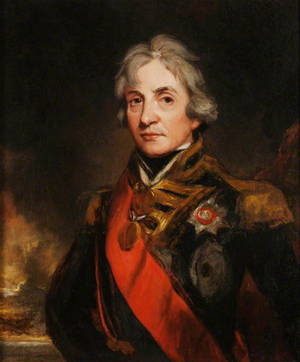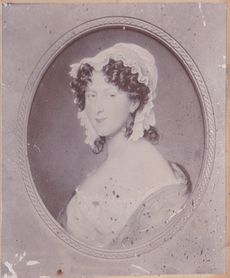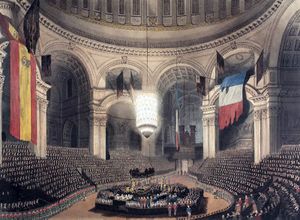هوراشيو نلسون
الڤايكونت نلسون Vice-Admiral The Viscount Nelson | |
|---|---|
 الأميرال هوراشيو نلسون، 1799، بريشة لمويل فرانسيس آبوت | |
| ولد | 29 سبتمبر 1758 برنم ثورپ، نورفوك، إنگلترة |
| توفي | 21 أكتوبر 1805 (aged 47) HMS Victory، مقابل رأس الطرف الأغر، إسپانيا |
| دُفـِن | كاتدرائية القديس پولس |
| الولاء | |
| الخدمة/ | |
| سنين الخدمة | 1771–1805 |
| الرتبة | نائب أميرال البيض |
| قيادات مناطة | Mediterranean Fleet |
| المعارك/الحروب | American War of Independence
|
| الأوسمة | Knight of the Order of the Bath |
| التوقيع | |
هوراشيو نلسون إنگليزية: Horatio Nelson (عاش 29 سبتمبر 1758- 21 أكتوبر 1805) نائب أميرال إنجليزي. اشتهر بمشاركته بمعركة النيل ومعركة الطرف الأغر، يعد أحد أبرز القادة العسكريين في تاريخ المعارك.
توفي نلسون يوم 21 أكتوبر 1805 وهو يقاسي بعد اصابته في العمود الفقري لدى وقوفه على مقدمة سفينته أثناء معركة طرف الغار التي غيرت التاريخ، على سواحل اسبانيا. واعتبرت المعركة بداية النهاية لغزو نابليون بونابرت امبراطور فرنسا لاوروبا، وأمنت لبريطانيا السيادة على البحار لأكثر من قرن.
His inspirational leadership, grasp of strategy, and unconventional tactics brought about a number of decisive British naval victories, particularly during the Napoleonic Wars. He was wounded in combat, losing sight in one eye in Corsica at the age of 35, and most of one arm in the unsuccessful attempt to conquer Santa Cruz de Tenerife when he was 40. He was fatally shot during his victory at the Battle of Trafalgar in 1805.
Nelson was born into a moderately prosperous Norfolk family and joined the navy through the influence of his uncle, Maurice Suckling, a high-ranking naval officer. Nelson rose rapidly through the ranks and served with leading naval commanders of the period before obtaining his own command at the age of 20 in 1778. He developed a reputation for personal valour and firm grasp of tactics, but suffered periods of illness and unemployment after the end of the American War of Independence. The outbreak of the French Revolutionary Wars allowed Nelson to return to service, where he was particularly active in the Mediterranean. He fought in several minor engagements off Toulon and was important in the capture of Corsica and subsequent diplomatic duties with the Italian states. In 1797, he distinguished himself while in command of إتشإمإس Captain at the Battle of Cape St Vincent.
Shortly after that battle, Nelson took part in the Battle of Santa Cruz de Tenerife, where the attack failed and he was badly wounded, losing his right arm, and was forced to return to England to recuperate. The following year he won a decisive victory over the French at the Battle of the Nile and remained in the Mediterranean to support the Kingdom of Naples against a French invasion. In 1801 he was dispatched to the Baltic and won another victory, this time over the Danes at the Battle of Copenhagen. He commanded the blockade of the French and Spanish fleets at Toulon and, after their escape, chased them to the West Indies and back but failed to bring them to battle. After a brief return to England he took over the Cádiz blockade in 1805. On 21 October 1805, the Franco-Spanish fleet came out of port, and Nelson's fleet engaged them at the Battle of Trafalgar. The battle became one of Britain's greatest naval victories, but Nelson, aboard إتشإمإس Victory, was fatally wounded by a French sharpshooter. His body was brought back to England where he was accorded a state funeral.
Nelson's death at Trafalgar secured his position as one of Britain's most heroic figures. The significance of the victory and his death during the battle led to his signal, "England expects that every man will do his duty", being regularly quoted, paraphrased and referenced up to the modern day. Numerous monuments, including Nelson's Column in Trafalgar Square, London, and the Nelson Monument in Edinburgh, have been created in his memory, and his legacy remains highly influential.
النشأة

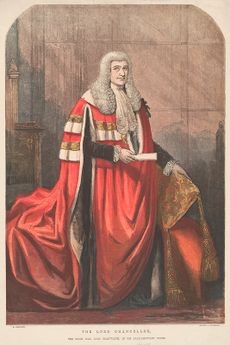
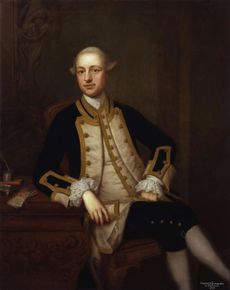
السيرة البحرية المبكرة

القيادة
الخدمة في البحر المتوسط
كورسيكا
Genoa and the fight of the Ça Ira
أميرال
معركة سانت ڤنسنت
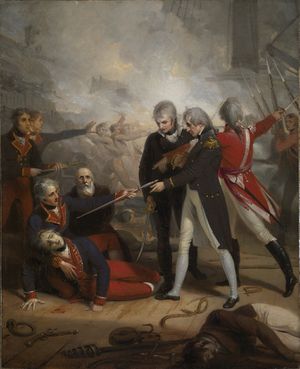
اصطياد الفرنسيين
معركة النيل
المكافآت
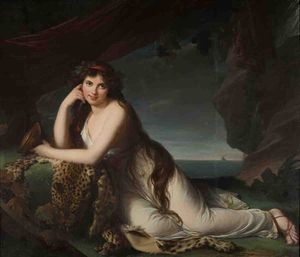
الحملة الناپولية
العودة إلى إنگلترة

Parker and the Baltic
معركة كوبنهاگن
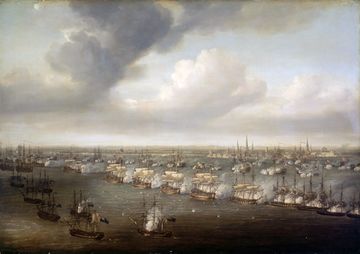
العودة إلى البحر
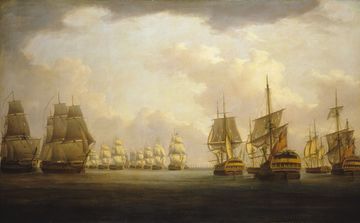
معركة الطرف الأغر

الإصابة والوفاة
Shortly after 1:00, Hardy realised that Nelson was not by his side. He turned to see Nelson kneeling on the deck, supporting himself with his hand, before falling onto his side. Hardy rushed to him, at which point Nelson smiled:
Hardy, I do believe they have done it at last .... my backbone is shot through.[2]

الجنازة
التقييم

Nelson was regarded as a highly effective leader, and someone who was able to sympathise with the needs of his men. He based his command on love rather than authority, inspiring both his superiors and his subordinates with his considerable courage, commitment and charisma, dubbed "the Nelson touch".[3][4] Nelson combined this talent with an adept grasp of strategy and politics, making him a highly successful naval commander. The memorandum he wrote before Trafalgar expresses his attitude well: "No captain can do very wrong if he places his ship alongside that of the enemy."[5]
الذكرى
انظر أيضاً
- Bibliography of 18th–19th century Royal Naval history
- Honor Harrington, a fictional character partially based on Nelson in later novels
- Nelson hold
- Turning a blind eye
ملاحظات
المراجع
- ^ Sugden 2004, p. 464
- ^ خطأ استشهاد: وسم
<ref>غير صحيح؛ لا نص تم توفيره للمراجع المسماةHibbert 370 - ^ خطأ استشهاد: وسم
<ref>غير صحيح؛ لا نص تم توفيره للمراجع المسماةLambert107-8 - ^ Lambert 2004, xvii
- ^ "Nelson's Trafalgar Memorandum". www.bl.uk.
<ref> ذو الاسم "The Heraldry Society" المُعرّف في <references> غير مستخدم في النص السابق.وصلات خارجية
- Hansard 1803–2005: contributions in Parliament by the Viscount Nelson
- أعمال من هوراشيو نلسون في مشروع گوتنبرگ
- Works by or about هوراشيو نلسون at Internet Archive
- Works by هوراشيو نلسون at LibriVox (public domain audiobooks)

- Collections related to Nelson held by the National Maritime Museum
- The Nelson Society
- Norfolk Nelson Museum
- Original Letters Written by Horatio Nelson Shapell Manuscript Foundation
- An essay on Nelson in The Oxonian Review of Books
- Nelson, history
- Review of A. T. Mahan's biography
| Peerage of Great Britain | ||
|---|---|---|
| سبقه (مستحدث) |
البارون نلسون (للنيل ولبرنم ثورپ) 1798-1805 |
تبعه (انقطع) |
| Peerage of the United Kingdom | ||
| سبقه (مستحدث) |
البارون نلسون (للنيل وهيلبورو) 1801-1805 |
تبعه وليام نلسون |
| سبقه (مستحدث) |
الڤايكونت نلسون 1801-1805 |
تبعه (انقرض) |
| ألقاب نبالة | ||
| سبقه (مستحدث) |
دوق برونته (في مملكة الصقليتين) 1799-1805 |
تبعه وليام نلسون |
- Short description is different from Wikidata
- Articles with hatnote templates targeting a nonexistent page
- Missing redirects
- Articles with redirect hatnotes needing review
- Articles containing إنگليزية-language text
- Pages using Lang-xx templates
- هوراشيو نلسون
- بحريون بريطانيون من حروب الثورة الفرنسية
- قادة بحريون بريطانيون من الحروب الناپوليونية
- British military personnel killed in action in the Napoleonic Wars
- وفيات بإطلاق النار في إسپانيا
- رفاق فرسان نشان الحمام
- Knights Grand Cross of the Order of Saint Ferdinand and of Merit
- Knights of the Order of the Crescent
- People educated at Norwich School
- People educated at Paston College
- أشخاص من نورفوك
- People from King's Lynn and West Norfolk (district)
- Old Norvicensians
- Viscounts in the Peerage of the United Kingdom
- English amputees
- Burials at St Paul's Cathedral
- أميرالات بريطانيون
- أميرالات البحرية الملكية
- People who died at sea
- Royal Navy personnel of the American Revolutionary War
